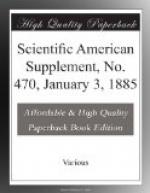* * * * *
SOUND SIGNALS.
In Appleton’s “Annual Cyclopaedia” for 1883, Mr. Arnold B. Johnson, Chief Clerk of the Lighthouse Board, contributes a mass of very interesting information, under the above title. His descriptions of the most approved inventions relating thereto are interesting, and we make the following extracts:
The sound signals generally used to guide mariners, especially during fogs, are, with certain modifications, sirens, trumpets, steam-whistles, bell-boats, bell-buoys, whistling buoys, bells struck by machinery, cannons fired by powder or gun cotton, rockets, and gongs.
Gongs.—Gongs are somewhat used on lightships, especially in British waters. They are intended for use at close quarters. Leonce Reynaud, of the French lighthouse service, has given their mean effective range as barely 550 yards. They are of most use in harbors, short channels, and like places, where a long range would be unnecessary. They have been used but little in United States waters. The term “effective range” is used here to signify the actual distance at which, under the most unfavorable circumstances, a signal can generally be heard on board of a paddle-wheel steamer in a heavy sea-way.
Guns.—The use of guns is not so great as it once was. Instances are on record in which they were quite serviceable. Admiral Sir A. Milne said he had often gone into Halifax harbor, in a dense fog like a wall, by the sound of the Sambro fog gun. But in the experiments made by the Trinity House off Dungeness in January, 1864, in calm weather, the report of an eighteen-pounder, with three pounds of powder, was faint at four miles. Still, in the Trinity House experiments of 1865, made in light weather with a light gun, the report was clearly heard seven miles away. Dr. Gladstone records great variability in the range of gun-sound in the Holyhead experiments. Prof. Henry says that a twenty-four-pounder was used at Point Boneta, San Francisco Bay, Cal., in 1856-57, and that, by the help of it alone, vessels came into the harbor during the fog at night as well as in the day, which otherwise could not have entered. The gun was fired every half hour, night and day, during foggy and thick weather in the first year, except for a time when powder was lacking. During the second year there were 1,582 discharges. It was finally superseded by a bell-boat, which in its turn was after a time replaced by a siren. A gun was also used at West Quoddy Head, Maine. It was a carronade, five feet long, with a bore of five and one-quarter inches, charged with four pounds of powder. The gun was fired on foggy days when the Boston steamer was approaching the lighthouse from St. Johns, and the firing was begun when the steamer’s whistle was heard, often when she was six miles away, and was kept up as fast as the gun could be loaded, until the steamer answered with its whistle.




